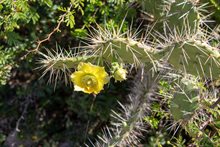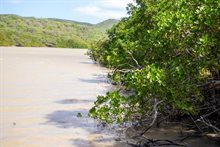What are the consequences for nature?
According to a study conducted by VU Amsterdam university, parts of low-lying nature reserves on Bonaire – the saliñas, Lac Bay, and the islet of Little Bonaire – will become permanently flooded as a result of the rising sea level by as early as 2050. The sections below explain how climate change will impact freshwater availability, land ecosystems, coastal erosion, and marine ecosystems.

Freshwater availability
In the Caribbean region, the supply of freshwater is already limited on account of the increasing demand and changes in land use. Climate change will result in decreased rainfall and rising temperatures. This poses the risk of reducing the freshwater supply even further. Salinisation is adding to this risk. As a result of sea level rise, tidal action, waves, and storm surges, seawater is encroaching further and further inland, which is gradually salinising both the soil and the water.
Salt lakes and caves
Climate change could also impact the salt plains and saliñas. Saliñas are salt lakes or salt bays that are closed off from the sea by a barrier of dead coral. They are important for various seagrass species, fish, crustaceans, and birds such as flamingos, terns, and sandpipers. Normally, the saliñas contain saline water, but during the rainy season, the water may turn almost fresh. Changes in precipitation patterns may compromise the volume of freshwater, which is harmful to the natural environment. Furthermore, salinisation and sea level rise may jeopardise freshwater caves, which are home to bats, shrimps, and a wide range of crustaceans.
Land ecosystems
In combination with storm surges, large differences between low and high tide, and higher waves, sea level rise can exacerbate coastal erosion. In addition, the cloud forests and rainforests of Sint Maarten, Sint Eustatius, and Saba are vulnerable to radical weather differences. Rising temperatures would cause the cloud forests of Saba and Sint Eustatius to grow higher, which would increase their exposure to extreme weather such as drought and hurricanes. This would render the lower-lying, drier areas more susceptible to wildfire. Furthermore, the islands could be at risk of a greater influx of exotic, non-indigenous plant and animal species. Indigenous species on islands are vulnerable in that respect.
Coastal erosion and marine ecosystems
Coastal and marine ecosystems are vitally important for the tourism industry. In addition, they constitute the habitat of countless animal species, and they protect the islands from damage caused by erosion, storm surges, and sea level rise.
Ocean acidification
The higher CO2 concentration in the atmosphere is causing ocean acidification, which is jeopardising molluscs and echinoderms, such as starfish, sea urchins, and sea cucumbers. Acidification is also jeopardising coral reefs, along with the fish and other animal species that are dependent on the coral.
Disappearance of seagrass
Seagrass is vulnerable to climate change too. For example, seagrass beds are affected by rising water temperatures and by a decrease in sunlight as a result of deteriorating water quality. According to experts, the worldwide volume of seagrass beds is declining by 7 per cent a year. Across the globe, 29 per cent of all seagrasses have already disappeared.
Disappearance of coral reefs
Ocean acidification, deteriorating water quality, and rising water temperatures pose the main threats to coral reefs. According to the World Wildlife Fund, almost half of all coral has disappeared over the past thirty years. An increase in coral bleaching has already been observed. According to the IPCC, half of all coral reefs in the world could be suffering from heat stress by around 2080. By 2074, coral bleaching could become increasingly serious in the Caribbean region. Even in a low-emissions scenario, coral bleaching in the Caribbean will start by 2030. More details are provided in the Coral reef health narrative in the Climate Impact Atlas for the BES islands.

Disappearance of mangrove forests
Mangrove forests serve as the breeding and feeding ground for countless animal species. In addition, they protect against coastal erosion and storms. Normally, they are quite resilient to sea level rise, but the combination of, inter alia, climate change, urbanisation, and tourism renders them vulnerable.
Want to read more?
The section below lists examples of publications, studies, and projects relating to the consequences of climate change for the natural environment.
- The study entitled Bonaire 2050: putting the vision into numbers, conducted by Wageningen University and Research (WUR), outlines various challenges facing Bonaire, such as erosion, drought, extreme weather, loss of biodiversity, and soil exhaustion. The study presents a nature-inclusive perspective on the future of Bonaire and compares it with a future in which things continue as they are.
- The report entitled Climate Change Effects & Recommendations by the Dutch Caribbean Nature Alliance (DCNA) contains an extensive overview of the impact of climate change on the Caribbean region. The report delves into the impact on nature and into the socio-economic effects. It also presents recommendations for adaptation measures at various scale levels.
- The Dutch Caribbean Climate Action Plan by the Dutch Caribbean Nature Alliance (DCNA) provides a concise overview of the impact of climate change, the consequences for the natural environment, and options for climate adaptation.
- The study entitled The impacts of climate change on Bonaire (2022-2023), conducted by VU Amsterdam university, provides an analysis of the consequences of climate change for Bonaire. Among other things, the study examines the risks of coastal flooding as well as potential consequences for the economy, for cultural heritage, and for public health.
- The 2022 IPCC fact sheet outlines the various consequences and risks of climate change for small islands in the Caribbean region, the Pacific, and the Indian Ocean. The fact sheet also provides information on potential climate adaptation measures and on issues that may hamper climate adaptation on small islands.
- One of the chapters of Het is nooit te laat (It is never too late), the advisory report drawn up by Ed Nijpels for the Bonaire Climate Table, presents a collection of scientific insights into the consequences of climate change for Bonaire.
- The Natuur en Milieu Caribisch Nederland (Nature and the environment in the Caribbean Netherlands) policy plan 2020-2030 sets out how the Netherlands aims to preserve and restore the natural environment of the Caribbean Netherlands, whilst additionally creating resilient ecosystems that will be used in a sustainable manner.
- The Klimaatalarm voor Bonaire (Bonaire Climate Alert) edition of Bon Bini Bonaire magazine deals with the consequences of climate change for the residents and nature of Bonaire, and outlines potential measures.
- The final report Integrated Water Management on Bonaire by the Rijn & IJssel Water Board outlines potential short-term and long-term solutions and measures to boost the climate resilience of the Bonaire water system.
-
The report entitled Klimaateffecten op Curaçao [Climate Impacts for Curaçao] outlines the potential main impacts of climate change on the island of Curaçao. The report is the result of a stakeholders’ workshop held in the autumn of 2023, organised by the Island(er)s at the Helm programme, NAAM, EcoVision N.V. and Climate Adaptation Services (CAS).
-
The report entitled Climate Impacts for Bonaire outlines the potential main impacts of climate change on the island of Bonaire. The report is the result of a stakeholders’ workshop held in the autumn of 2023, organised by TERRAMAR, Island(er)s at the Helm, Climate Adaptation Services (CAS), the Royal Netherlands Meteorological Institute (KNMI) and Wageningen University & Research (WUR).
- The report entitled Climate Impacts on Aruba outlines the potential main impacts on the island of Aruba. The report is the result of a stakeholders' workshop held in January 2025, organised by the National Climate Resilience Council Aruba (NCRC), the Ministry of Transport, Integrity, Nature en Elderly Affairs, the International Panel on Deltas and Coastal Areas (IPDC) and Climate Adaptation Services (CAS).